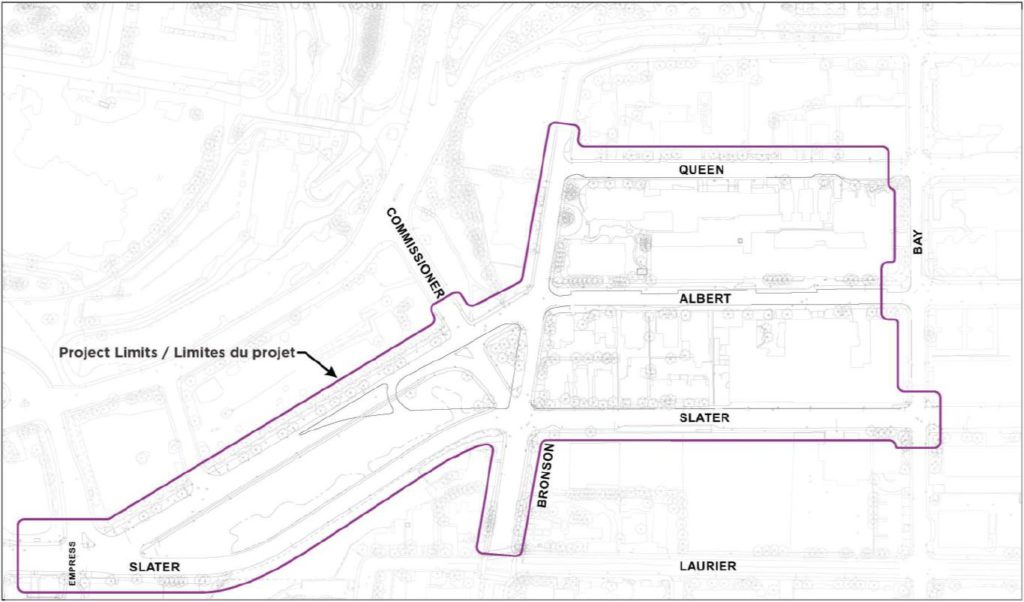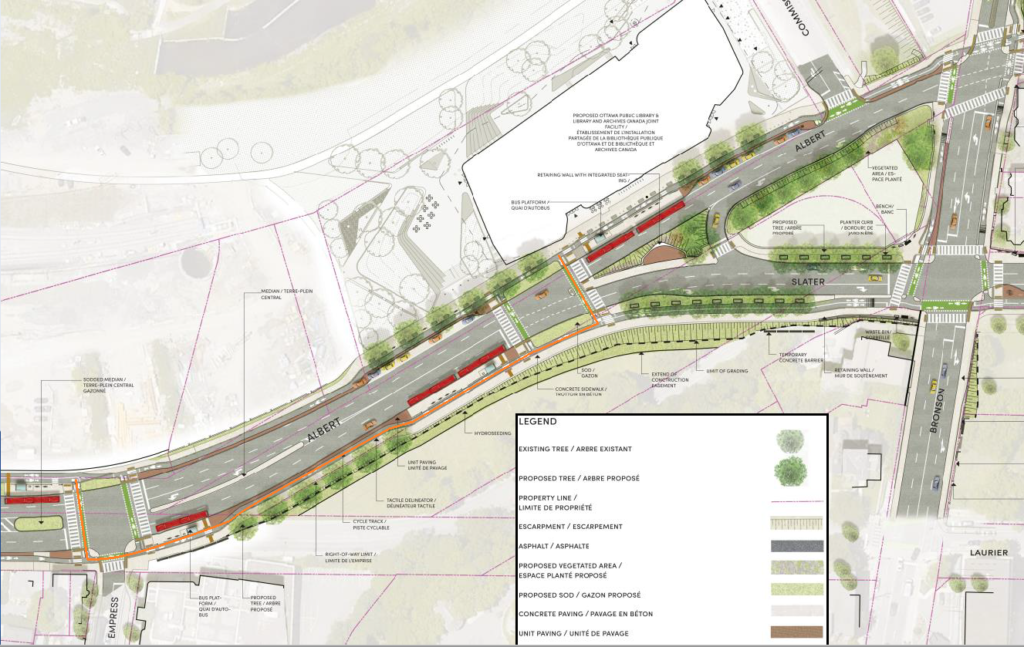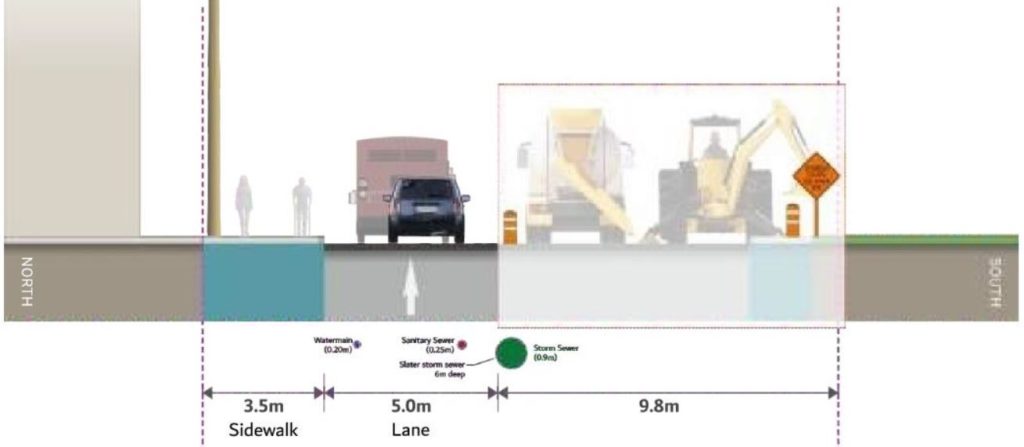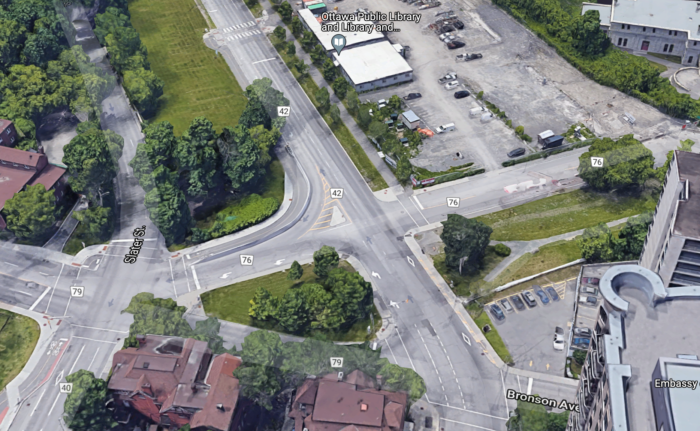Earlier this fall, the City released its latest plans for the reconstruction of several streets in a chunk of northwest downtown. As with many of the City’s reconstructions, this one was prompted by the need to rehabilitate and replace underground infrastructure in the area, but it will also involve the installation of new bicycle and pedestrian facilities.
Good bicycle and pedestrian facilities are important here for a number of reasons. First of all, this portion of the City features the highest numbers of people using active transportation. It is critical that they be safe and comfortable. Second, this project includes what the City has designated as one of its crosstown bikeways, according to the 2013 Transportation Master Plan. Third, this project will connect downtown to Ādisōke, the new Ottawa Public Library and Library and Archives Canada joint facility.

Bike Ottawa already contributed to this project at an earlier stage. You can check out our letter from September 2020 here. As you’ll see, the City has taken a few of our recommendations, which is somewhat encouraging; several of our other recommendations, however, unfortunately went unanswered.
Bike Ottawa feels the latest designs for this project have many good aspects. We’re pleased to see cycle tracks in most parts of this reconstruction. Cycle tracks afford people on bikes actual, physical protection, and the increased comfort can make the difference between a person biking or not biking. We’re also pleased to see protected intersections in many locations. Intersections are particularly dangerous for people on bikes, and protected intersections mitigate this danger considerably.
But there are a number of aspects of the latest design that we think call for reconsideration, some serious. Here are a few highlights:
- The City has insisted on using sharrows on Queen St. and Bronson just south of Queen. Research shows that sharrows are associated with greater injury to people on bikes than if nothing was there. This decision is particularly egregious in that on Queen, they devote what space could be used for safe infrastructure to…you guessed it: car parking. This also means people on bikes can be easily doored along this stretch.
- The City has put most of the bicycle parking on Albert and Slater on the opposite side of the street from the cycle track; this means if you want to park your bike, you’ll either have to cross high-speed car traffic or walk your bike for a couple minutes. This is an easy fix: replace car parking with bicycle corrals. (Here’s a nice visual.) We’ve also asked for a raised crosswalk, but the City has so far refused.
- At the City’s presentation on 23 November 2021, City staff admitted that most construction detours will not offer dedicated facilities for people on bikes, but every detour provides access by car; in other words, the City is willing to risk the safety of people on bikes to ensure “[car] traffic flow.” (You can check out one example below.) We find this unacceptable.


You can find the rest of our feedback in our letter below.
We don’t know yet when construction will begin; the next update will be in winter/spring 2022.
Stay tuned!
To: Patrick Duquette, Senior Engineer, City of Ottawa
Cc: Catherine McKenney, Councillor (Ward 14)
Via email: Patrick.Duquette@ottawa.ca, catherine.mckenney@ottawa.ca
Date: December 13, 2021
Subject: Reconstruction of Albert Street/Queen Street/Slater Street from Empress Avenue to Bay Street and Bronson Avenue from Queen Street to Laurier Avenue
Dear Mr. Duquette,
Bike Ottawa is a non-profit, volunteer-based organization that advocates for safe cycling infrastructure in Ottawa. We write to provide feedback concerning plans for the reconstruction of Albert Street/Queen Street/Slater Street from Empress Avenue to Bay Street and Bronson Avenue from Queen Street to Laurier Avenue.
We are glad to see efforts underway to improve active transportation facilities on Albert Street, Slater Street, Bronson Avenue and Queen Street.
We are glad to see several specific measures in this area:
- The construction of protected bicycle facilities in most parts of this project.
- The installation of protected intersections at Slater Street and Bronson Avenue, Albert Street and Bronson Avenue, and Slater Street and Bay Street.
- Efforts to limit the speed of motorists through design, including narrowing travel lanes on Queen Street, curb extensions and speed tables, and a raised intersection at Bronson Avenue and Queen Street.
We also thank you for your response to our letter dated September 1, 2020. We would like to follow up on several points in your response:
- We are pleased that the City has considered our suggestion for eliminating the right turn on red at Slater and Bronson. We nevertheless request that it be eliminated throughout the project zone, and dedicated signalization for people on bikes and pedestrians be implemented. Intersections are well known to pose a particular danger to vulnerable road users.
- We are pleased that depressed concrete curbs will be eliminated whenever possible in the transitional zone between the road and cycle track. Curbs reduce the comfort level for people on bikes and require extra energy to negotiate.
- We were pleased to learn that all cycling facilities will be designed with winter maintenance in mind.
- We reiterate our recommendation of raised mid-block pedestrian crossings on Queen St. We consider the reason provided against these—that “The Queen St speed humps are too tightly spaced to warrant pedestrian crossings”—as irrelevant; it implies that the City wishes pedestrians to cross where there are no crossings, which is unsafe. A block this long with so many pedestrians must have designated mid-block crossings, and by raising them, it also ensures further compliance with the designed maximum speed of 30 km/h.
We would also like to add recommendations based on the latest plans for this project:
- That the widths of cycling facilities be between 2.0 m and 2.5 m, as recommended in the Ontario Traffic Manual, Book 18. Since this is a major east-west corridor for people on bikes, it will have high volumes of people biking. Moreover, cycling facilities should be designed to accommodate non-standard bicycles: cargo bikes already are used across our city as family transportation or to deliver goods, and certain bikes are used as accessibility devices for those with disabilities. We were disappointed that information about the width of these facilities was omitted from the latest presentation, even though it was provided on earlier presentations.
- That Queen St. be made safer for people on bikes. Current plans show sharrows, whose use Bike Ottawa does not approve of except in temporary circumstances, such as wayfinding around construction zones. Research shows that roadways with sharrows are in fact associated with more injuries to people on bikes than if there were nothing at all. Current plans also show car parking along this roadway. In this configuration, there is insufficient space to prevent dooring, which can injure or kill people on bikes. As such, this configuration prioritizes the temporary storage of vehicles over the safe passage of people on bikes, which violates complete-streets policy. A dedicated bicycle facility is particularly necessary in light of the high volumes of vehicular traffic during evening rush hour, but also in light of the retirement residence in the area. Bicycles are an excellent mobility device for the elderly, but properly protected facilities are imperative to their safety.
- If the City insists on not providing cycling facilities along Queen Street, we recommend that the space currently taken by the median proposed in the car facilities where Queen meets Bronson instead be used for a continuation of the northbound cycle track on Bronson to enable people on bikes to negotiate this corner in safety.
- That automobile facilities on Bronson between Queen and Albert be made one-way southbound with a dedicated segregated cycling facility, in accordance with a complete streets model. As mentioned above, Bike Ottawa does not approve of the use of sharrows. At the very least, the space currently taken by the median proposed in the car facilities should instead be used for a cycle track at the north portion of this intersection to enable people on bikes to safely merge into cycling facilities along Albert. In addition, traffic-calming measures should be implemented on this portion of Bronson to slow cars to 20 km/h, as on Woodroffe Ave going downhill approaching the Sir John A. MacDonald Parkway.
- That the current cycle track on Albert Street be maintained as bidirectional from Empress Avenue to the library. We expect many people on bikes to access the library from the west, and doing so in the current configuration would force them to cross Albert Street twice. Apart from the unnecessary inconvenience this represents, any crossing of Albert also poses a threat, and given people will likely be biking with children, leave the bidirectional lane as it is to make connecting to the library safe and easy. It is likely we will find people biking in the proposed uni-directional lane, rather than unnecessarily crossing the street several times.
- That trees proposed for Albert Street between Empress Avenue and Bronson Avenue be planted between the cycle track and the road. Creating an additional physical barrier between motorists and the cycle track offers an additional level of protection for people on bikes from vehicles, as well as a level of attractiveness. Similarly, trees should be planted where bulb-outs on Slater Street and Albert Street east of Bronson Avenue can accommodate them.
- That bicycle parking along Albert Street and Slater Street be located on the same side of the street as the cycle track. Locating it on the opposite side of the street will force people to cross high-speed car traffic while walking their bikes. This is an inaccessible design, as some people use bicycles as accessibility devices and are unable to navigate over curbs. We recommend locating bicycle parking between car facilities and the cycle track, which offers the additional benefit of further protection for people on bikes from vehicles. Alternatively, a certain number of car-parking spaces could be replaced by bike corrals.
- That the crossing in the turn lane from Albert to Slater in front of Ādisōke (Ottawa Central Library and Library and Archives Canada) be raised. Raising crossings encourages drivers to comply with pedestrian right-of-way and therefore improves safety.
- We are concerned about the white hashing that protrudes into the cycle track on Albert Street east of Bronson Avenue. If this indicates a barrier, we ask that the barrier be removed. Barriers in cycle tracks may prevent larger bicycles, such as cargo bikes or tricycles used as mobility devices, and City maintenance crews from accessing these facilities.
- That dedicated cycling facilities be provided during all phases of this project. We noted during the presentation that dedicated cycling facilities will be provided in only some cases. Forcing people on bikes to mix with automobile traffic—particularly when some of this traffic consists of construction vehicles—poses an unacceptable danger to them.
We thank you in advance for your careful consideration of our recommendations and ask for a reply to them. We would be glad to answer any questions you may have to work with you on any aspect of this project relating to active transportation.
Sincerely,
William van Geest
Advocacy Working Group, Bike Ottawa
advocacy@bikeottawa.ca

